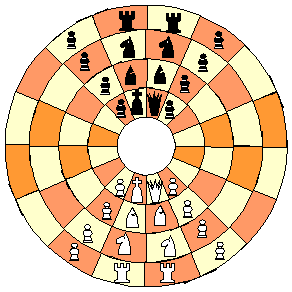Hexagonal Round Chess
| Contents: |
Introduction
The
Hexagonal Round Chess is a merge of Byzantine chess (so called Round
chess) and
REX chess
(Figures
1, 2 and 3). The rules are like Byzantine chess and
pieces movement like REX chess.
The Hexagonal Round Chess board is REX
chess board in round shape. When the REX
board is forced in round shape, the hexagons are distorted and 4 grey cells in
lateral side are removed. Two cells of them have 2 Pawns (one white and other
black), and they are removed too. The board was conceived such that the central
line (radius 5, see forward Figure 5) is
formed by grey hexagonal cells, as REX
chess. This board chess is comprised of 81 hexagonal cells filled in white,
black and grey colors (see forward Figure 3).
This game was invented in November / 2002, by Arnaldo Rodrigues D'Almeida. I was
reading about Byzantine chess when I had the idea of merging it with REX
chess.
Figure 1: Byzantine chess. Figure 2: REX chess.


Figure 3: Hexagonal round chess.

Movement of the pieces
The players will move the pieces, one per time, alternately. Each player shall only move the pieces of his color. The pieces are moved according to Figure 4.
Figure 4: Movement of the pieces.

The Queen, not shown in the Figure, can be moved along the diagonal, as Bishop, or along the orthogonal, as Rook. The hexagonal cells on the way of the full arrows can be occupied in one move. The pieces can only occupy hexagonal cells that are unoccupied or occupied by opponent's pieces (of another color), if there are no other piece in the way. The Knight is the only piece that can jump the other ones, in other words, a piece on its way doesn't impede it of occupying an empty hexagonal cell or an hexagonal cell occupied by the opponent. The King cannot be moved to hexagonal cells where it can be captured (to see Capture further on). The Pawn only moves forward in its specific direction. The Pawns positioned on hexagonal cells on angles e, f, o and p (see Figure 1) can be moved clockwise. The Pawns positioned on hexagonal cells on angles a, b, j and l (see Figure 3) can be moved anticlockwise
Coronation of the Pawn - The Pawn when arriving at angles c, d, m or n it leaves the board, giving place to the other piece, except the King, to be chosen by the player.
Capture - When one piece occupies an hexagonal cell occupied by an opposing piece, this piece leaves the board and it means that it has been captured.
Check / Checkmate - When a piece threatens to capture the opposing King (King in check), the player shall say the word "check" and indicate which piece that is threatening, if necessary. In the following move, the opponent must necessarily move, protect the King (by placing a piece between the King and the piece that threatens the King), or capture the piece that threatens the King. If it is impossible to avoid the menace, Checkmate is said. In this case, the player in that situation loses the game.
Rules
1- Objective - The players have as objective:
(1) to checkmate (to see further on) the opponent, or
(2) to impede that the opponent player moves any of his pieces, or
(3) to capture all opponent player's pieces, except King (King alone).
2- All the pieces
capture the same way they move;
3-
"En passant"
captures are allowed.;
4- Pawn promotes when arriving at angles c, d, m or n.
5-
There is no castling.
Win - The player wins the game when the opponent: (1) receives checkmate, (2) cannot move any of his pieces, (3) loses all his pieces (king alone) and soon after the next move he cannot capture the last piece of the other player, or (4) gives up the game (abandons), at any moment.
Tie - The tie can happen when: (1) there are insufficient pieces to win, (2) there is a repetition of move by 3 serial times, (3) the king alone (the player loses his pieces) and soon after the next move the player must capture the last piece of the other player (King x King), or (4) one of the players proposes tie to the opponent, what can happen at any moment of the game, and it is accepted by him.
Notation
The notation is good to record the moves of a match. The analysis of the matches, move by move, will allow the player to learn the tactics and its opponent's strategies. Besides, you can notice your mistakes and successes, what will contribute to improve your performance.
The characteristics of the circular chess required that the notation is based on Polar coordinates. The position is determined by angle and radius. The Figure 5 shows the Polar alpha-numeric notation. The angles are represented by letters and the radii are represented by numbers. This notation allows to correlate, by means of equations, the movements of the pieces, what is fundamental in the computers programs.
Figure 5: Polar alpha-numeric notation.

The notation of a move is described as, hexagonal cell of origin-hexagonal cell of destiny. For example, in the beginning of the game (Figure 3), the white pieces can begin with the following move: c2-s1. That move means that the Knight located in c2 was moved for s1.
ion
Board
You can make download of the board.
Links
